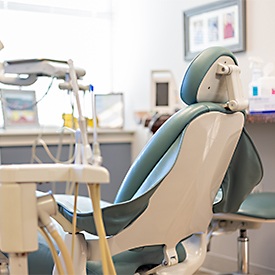 La Plata
La PlataDental
 La Plata
La Plata
 Gum disease, also called periodontitis or periodontal disease, affects millions of US adults. Our goal at La Plata Dental is always to keep your gums healthy and prevent periodontal disease. During regular dental checkups, we screen for the warning signs of gingivitis, the mild form of gum disease. At this stage, we can typically renew and improve oral health with more frequent professional cleanings and improved at-home hygiene. Call our La Plata dentistry practice to find out more or schedule an appointment. We’ll examine your smile for the symptoms of gingivitis and periodontal disease, including bleeding gums, inflamed or discolored soft tissue, receding gum line, and chronic bad breath.
Gum disease, also called periodontitis or periodontal disease, affects millions of US adults. Our goal at La Plata Dental is always to keep your gums healthy and prevent periodontal disease. During regular dental checkups, we screen for the warning signs of gingivitis, the mild form of gum disease. At this stage, we can typically renew and improve oral health with more frequent professional cleanings and improved at-home hygiene. Call our La Plata dentistry practice to find out more or schedule an appointment. We’ll examine your smile for the symptoms of gingivitis and periodontal disease, including bleeding gums, inflamed or discolored soft tissue, receding gum line, and chronic bad breath.
If we’re unable to prevent gum disease or halt it in the early stages, we may need to perform a more advanced set of procedures called scaling and root planing. We begin by numbing the soft tissue to ensure your complete comfort. Then, we use an instrument called an ultrasonic scaler to remove all of the plaque and tartar buildup at and below the gum line. Root planing is paired with scaling to prevent future buildup of plaque and tartar that can make periodontal disease more severe. Planing is the smoothing of tooth roots that removes the deep pits and grooves on the surfaces of teeth that allows plaque to take hold. If scaling and root planing are not effective in repairing the smile, we may need to provide more advanced services.

Do you want to know more about gum disease and periodontal therapy? Our expert staff has collected some of the most common questions about gum disease and answered them below. From the early warning signs to whether you can blame gum disease on your family genes, it’s all right here. Of course, if you think you could benefit from periodontal therapy, do not hesitate to contact our office right away.
One common symptom of gum disease is bleeding gums, especially when brushing or flossing. However, many early warning signs of gum infections are subtle and cannot always be detected at home. That is one reason why it’s so important to schedule preventive checkups with a dentist every six months.
In addition to bleeding gums, the following symptoms are all tell-tale signs of gum disease:
Your family genes could influence the health of your gums. According to the American Dental Association, genetics is a risk factor for developing gum disease. If you know of family members that also struggle with their gum health, be sure to mention this to your dentist at your next checkup. Understanding your family health history and whether you are more susceptible to gum disease will help our team develop a personalized prevention or treatment plan.
Gingivitis, the first stage of gum disease, often does not cause any pain. However, that makes this type of oral infection all the more dangerous. Because many people with gingivitis do not experience discomfort, they may push off seeking treatment. In some cases, they may not even realize they have gum disease at all! Meanwhile, the infection in their gum tissue may end up worsening. To avoid reaching an advanced stage of gum disease, be sure to schedule regular dental checkups.
The good news is that gum disease can be cured if it is detected early on! Gingivitis can typically be reversed with frequent professional cleanings and extra brushing and flossing at home. When it comes to gum health, a little prevention goes a long way.
If gum disease is allowed to worsen, however, treatment becomes more complicated. Your dentist may need to perform a more advanced set of procedures called scaling and root planing. Advanced gum disease, also known as periodontitis, can only be treated, not cured.
Most dental insurance plans cover around 50% of the cost of scaling and root planing, or gum “deep cleaning”. However, every insurance plan is slightly different. Before committing to periodontal treatment, be sure to confirm your coverage with your insurance provider. If you need help understanding the details of your insurance plan, our knowledgeable team will be happy to assist you. We are committed to providing affordable periodontal care and will work on your behalf to maximize your insurance benefits!